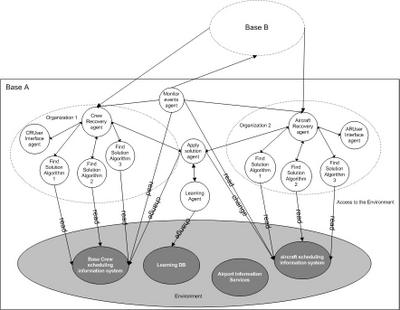- We hypothesize that the main objective of airline operation (that is, flights always on
time) will be much easier to achieve (that is, less flights delayed) if we take advantage of the fact that the crew members belong to different bases. We predict that if we solve the problems first with local resources and then with non-local resources, the solutions to the eventual problems will be much faster to find and, in some cases, the non-local solutions might be the only solution available. - Second, we hypothesize that the use of different algorithms to solve the same problem (in crew and aircraft recovery) will improve the achievement of the main objective of the crew and aircraft recovery process (that is, to always find the better solution regarding “ensuring every flight has a crew” and “ensuring that all flights are on time”, respectively). We predict that using different algorithms (genetic algorithms, heuristic, etc.) in comparison with using always the same algorithm, to solve the same problem, will permit to (1) always find the best solution (according to the criteria defined by the company) and (2) to always find a solution, especially taking into account the fact that we might benefit from solutions presented by other bases, as stated in the first hypothesis.
- Third, we hypothesize that the implementation of a learning mechanism that will learn from the use of crew members (in comparison with the previous and published schedule and in characterizing specific situations) will permit a better use of the resources (especially crew members) in future schedules. We predict that, for example, if we learn the real use of stand by crew members in each month and in specific situations, will allow adjusting the stand by roster in similar months or similar situations of future schedules, permitting to release crew members to be schedule to flights (crew members are one of the most expensive resources in an airline company).
- Forth, we hypothesize that if we extend the learning mechanism to learn the profile of each crew member, regarding his/her preferences, will increase the level of satisfaction of them. We predict that applying the learned profile of each crew member in future schedules of corresponding months will produce a roster that will achieve the goals of the airline company and, at the same time, the satisfaction of the crew members. Increasing the level of satisfaction of a crew member will decrease the crew member’s absence to work.

Finally, Section 6 - Future work, gives an overview of what we would like to explore in the future. So, click the title of this post, read the document and comment the other related posts.

No comments:
Post a Comment